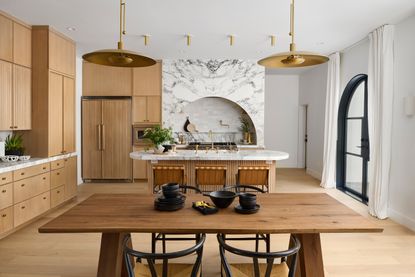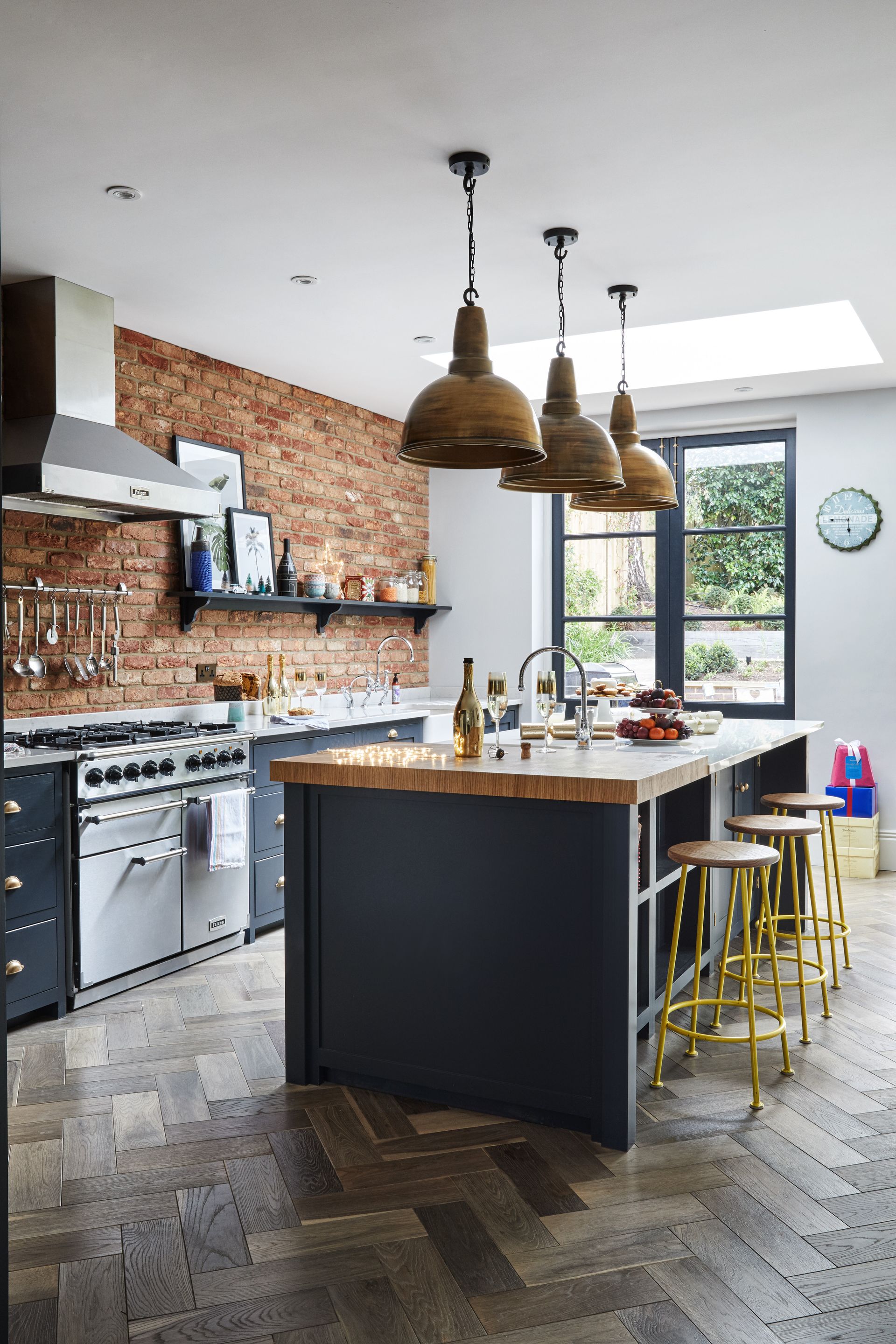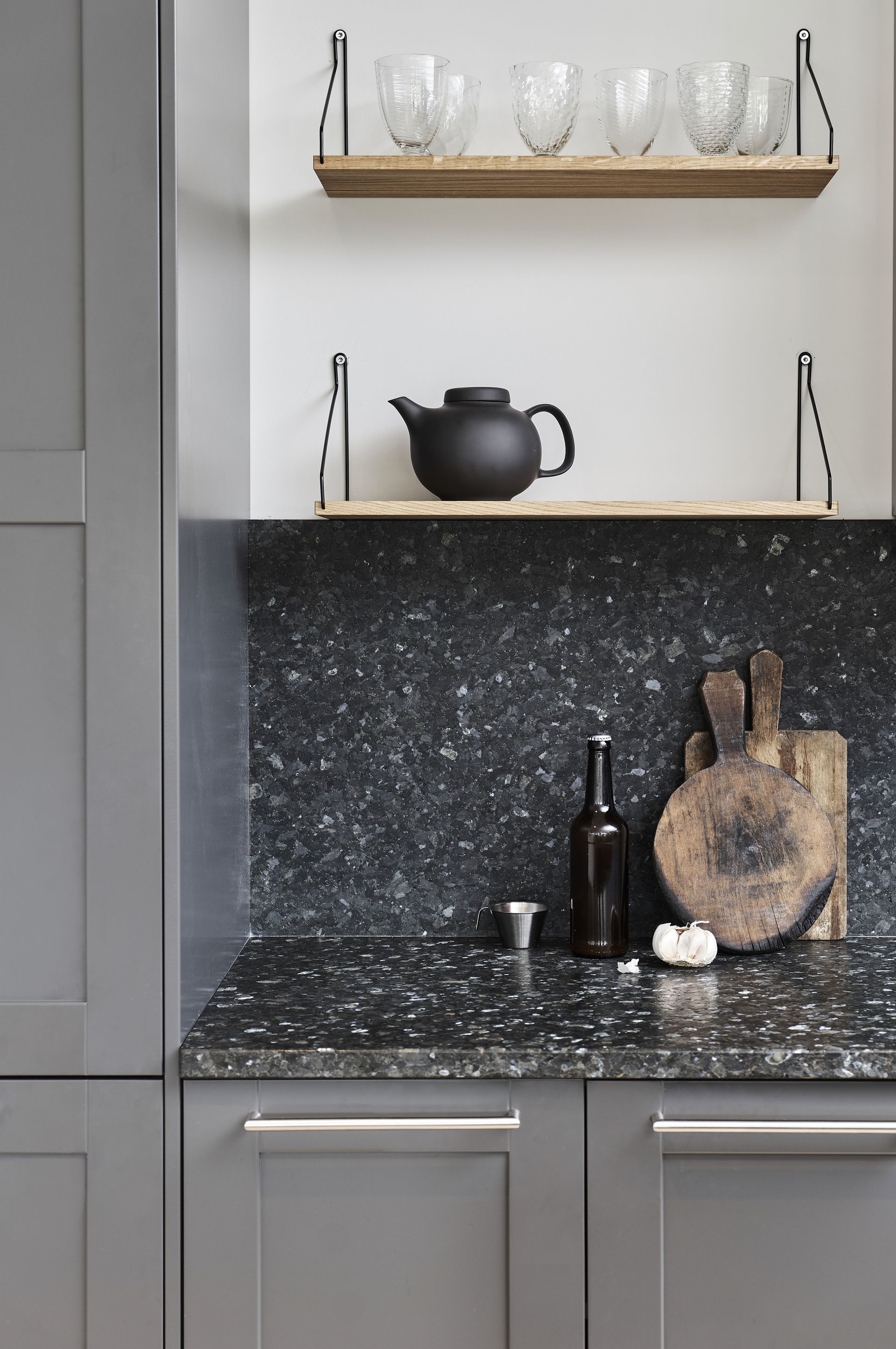How much overhang should you have for a countertop? Here's what kitchen designers have to say
Countertop overhang plays a vital role in your kitchen, both in style and practicality. Here's how much you should account for


When it comes to a new kitchen, there are a few design choices we tend to prioritize. Alongside our cabinetry, countertops are one of the first. Although their aesthetic qualities usually bear the most influence, we're often guilty of overlooking some of the more nitty-gritty details, such as the question of how much they should overhang.
Countertops are an integral part of modern kitchens. From a practical point of view, they have to be durable enough to withstand heat, stains and sharp knives, but overhang also plays an important role in regards to their functionality. The amount your countertop extends over your base cabinets can really impact the overall efficiency of your kitchen, so it's probably a more important factor than you first thought.
When it comes to ironing out these finer details, we know that things can get pretty overwhelming. Would the overhang of your island countertop differ to regular countertops, for example? And how does the type of material you've used factor in? Fear not. To help get to the bottom of these questions, we've rustled up some insight from a few kitchen designers who know their stuff.

Lilith is an expert at following news and trends across the world of interior design. She's committed to helping readers make the best choices in their homes through sharing practical tips and guides that promise to maximize both style and functionality. For this piece she asked kitchen designers how much our countertops should overhang. Here's what they had to say
How much overhang should you have for a countertop?

Before we go any further, let's clear up any confusion as to what a countertop overhang actually is. In short, it's the distance from the leading edge of the kitchen countertop to the edge of your base cabinet or appliance below. You probably don't give this small detail of your kitchen very much thought, but it plays a more important role than you might think.
'Overhang is very important because it protects the cabinet and cabinet hardware from food spills,' says Jennifer Bell, co-owner of VP & Kitchen Designer of Summit Remodeling. 'They also help hide any minor alignment issues or imperfections on the top of the cabinets themselves.'
So how many inches should your overhang actually be? In general, the recommended countertop overhang is between 1 and 1.5 inches. 'The standard overhang measurement is based on the fact that most people find this distance be the perfect place to rest their forearms while food prep is taking place,' notes Chris Alexakis, founder of CabinetSelect. This applies to all sides of the countertop apart from the side that's up against the wall.
What about for an island or breakfast bar seating?

So far, we've been talking about the regular countertop surfaces around the side of your space. When it comes to kitchen islands or breakfast bars, your overhang will most likely be different since we often make use of open-shelved storage or seating below these spaces.
'On an island or breakfast bar the overhang would typically be greater as homeowners are looking for space for seating,' Jennifer explains. 'A typical overhang for seating is 12 inches, but anything from nine to twelve is good if the spacing is more limited.' This allows you to comfortably bend your knees when sat down or tuck in seating when it's not being used and, as mentioned, prevents any damage to storage from spillage.
Of course, if you opt for a waterfall countertop, your overhang will only apply to those edges where your surface material isn't dropped to the floor.
What's the minimum countertop overhang you can have?

If you have a small kitchen, you might be conscious about the size of your overhang. When floor space is limited, like in a galley kitchen, the more your countertop protrudes the more minimized your comfortable walking space becomes. Since we've established its importance, the thought of no overhang at all is out of the question, but just how small can your overhang be?
'The minimum overhang on a standard base cabinet or vanity I recommend is 1 inch, although do feel that 1.5 is the way to go,' says Jennifer. 'When it comes to seating, I wouldn't suggest anything below nine inches because anything smaller leaves very little space for a chair. This will make it awkward when a person is sitting as they'll be too far away from the countertop which isn’t ideal for eating or working.'
Even in the smallest of kitchens one inch of space isn't too much to lose, and you'll probably be thankful for it in the long term. While a shorter overhang can save space, Chris is quick to mention that it's not usually recommended. 'A smaller overhang can make it difficult to chop vegetables or mix ingredients, which is the main reason people choose one in the first place,' he says. 'It's generally better to have a little extra room for overhang than to risk reducing the overall functionality of your kitchen space.'
What about maximum overhang?

If space allows it, and you want your glamorous marble or quartz countertop to make a design statement, you might consider a larger overhang. Bearing in mind that you'll need to be able to comfortably reach across the countertop, the maximum amount of overhang you should have is around 12 inches.
Besides the practicality of using the work surface, you'll also need to maintain structural integrity. 'While it's possible to extend the countertop beyond a point of 12 inches, you'll most likely need to use additional supports or brackets to keep it from sagging or buckling,' Chris notes.
The stage at which you'll need to consider additional support largely depends on the type of material you're using. 'The most common countertop being used right now due to its wonderful maintenance-free qualities is Quartz, which can go up to 15 inches of overhang before needing extra support,' Jennifer explains. Marble and granite, on the other hand, will probably need additional support if your overhang is more than eight inches long. The depth (and weight) of your countertop may affect this, too.
Don't be put off by the idea of installing supporting columns or brackets, though. 'Cabinet companies often sell decorative support brackets or corbels which really add to the aesthetic and make the kitchen look richer and more custom,' adds Jennifer. We love this curved corbel design available from Amazon, after all, there's never a need to sacrifice style for functionality!
Be The First To Know
The Livingetc newsletter is your shortcut to the now and the next in home design. Subscribe today to receive a stunning free 200-page book of the best homes from around the world.

Lilith Hudson is the News Editor at Livingetc, and an expert at decoding trends and reporting on them as they happen. Writing news, features, and explainers for our digital platform, she's the go-to person for all the latest micro-trends, interior hacks, and color inspiration you need in your home. Lilith discovered a love for lifestyle journalism during her BA in English and Philosophy at the University of Nottingham where she spent more time writing for her student magazine than she did studying. After graduating, she decided to take things a step further and now holds an MA in Magazine Journalism from City, University of London, with previous experience at the Saturday Times Magazine, Evening Standard, DJ Mag, and The Simple Things Magazine. At weekends you'll find her renovating a tiny one-up, one-down annex next to her Dad's holiday cottage in the Derbyshire dales where she applies all the latest design ideas she's picked up through the week.
-
 The 12 Best Table Lamps for Reading —I'm a Certified Bookworm (and Shopping Expert)
The 12 Best Table Lamps for Reading —I'm a Certified Bookworm (and Shopping Expert)When it comes to table lamps for reading, I don't mess around. If you're the same, this edit is for YOU (and your books, or course — and good recommendations?)
By Brigid Kennedy Published
-
 "It's Scandi Meets Californian-Cool" — The New Anthro Collab With Katie Hodges Hits Just the Right Style Note
"It's Scandi Meets Californian-Cool" — The New Anthro Collab With Katie Hodges Hits Just the Right Style NoteThe LA-based interior designer merges coastal cool with Scandinavian simplicity for a delightfully lived-in collection of elevated home furnishings
By Julia Demer Published

